
UNIQUE, GROUNDBREAKING CAPABILITIES THAT STAND THE TEST OF TIME





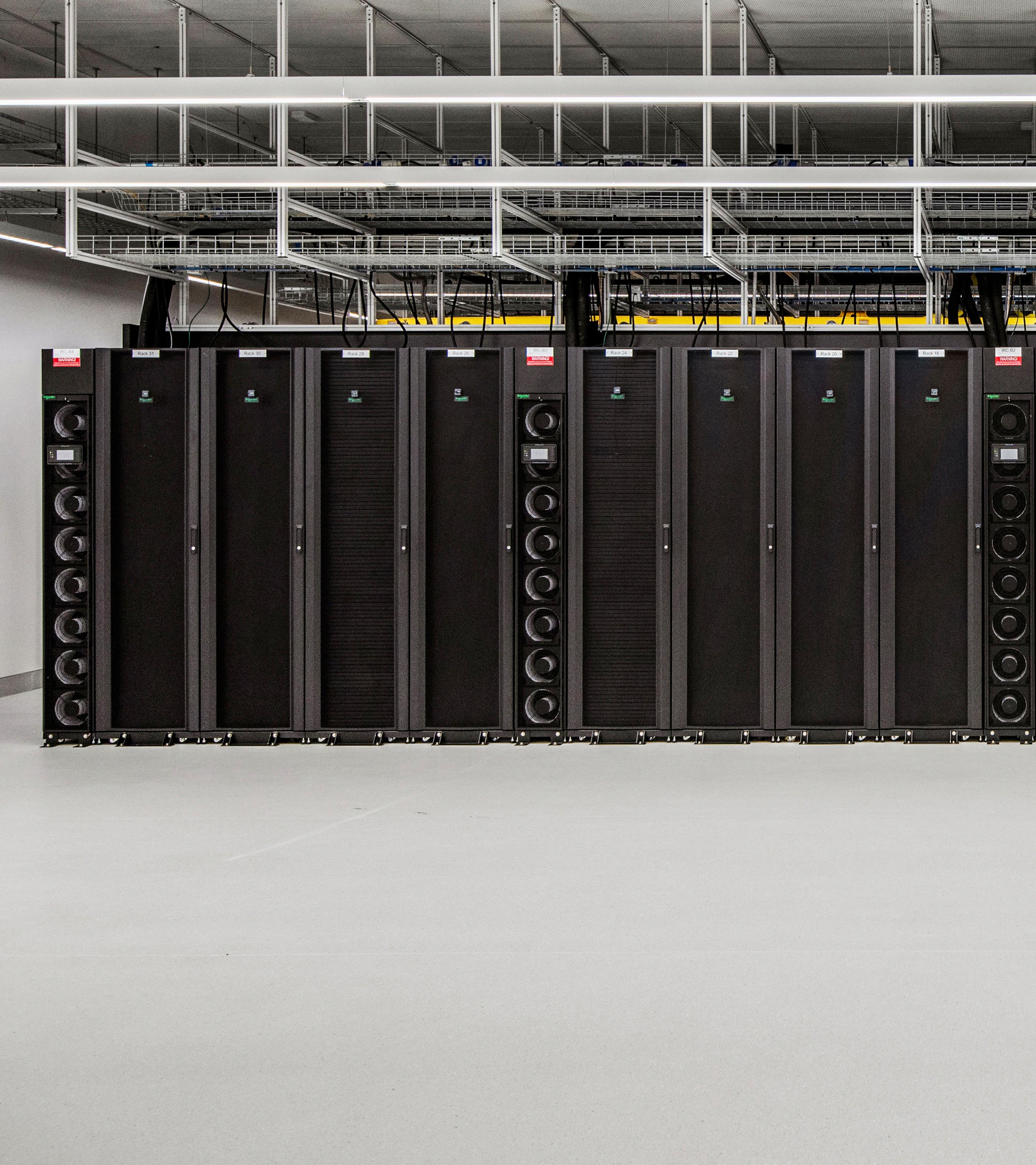








CDC is equipping New Zealand’s digital landscape with unique, groundbreaking data centre capabilities that stand the test of time. Andrew Kirker, Managing Director – New Zealand and Hyperscale ANZ, tells us about the company’s journey to become the pioneer of hyperscale cloud and artificial intelligence services across the country
Writer: Lucy Pilgrim | Project Manager: Sam Thomas

The data centre market across Australia and New Zealand (ANZ) has significantly pro gressed in recent decades, primarily driven by the rise of colocation, cloud computing, and graphics processing units (GPUs) for artificial intelligence (AI), making for a digital landscape that is increasingly in demand.
At the forefront of this growth is CDC, established 18 years ago in Australia by the company’s Founder and CEO, Greg Boorer, who is still at the helm of the business today.
After working overseas in Europe for many years, Boorer returned to Australia in the early 2000s having gained valuable insight into the then-recent evolution of the global data

centre industry, which contrasted with the limited infrastructure found in his home nation, thereby revealing a major gap in the market.
“When he came back to Canberra in Australia, Boorer found there was a significant opportunity in this space, particularly when working with the government who, up to that point, had approximately 300 server rooms rather than mission-critical data centres,” opens Andrew Kirker, Managing Director – New Zealand and
Indeed, the government relied on outdated data centres often in the basements of ageing buildings to run critical systems like welfare, tax, and immigration services.

As the digital economy accelerates, EonFibre is positioned to deliver robust, future-ready connectivity solutions for data centres, MNOs, cloud providers and internet service providers (ISPs). The business is optimised to meet the rising demand for scalable, tier 1 fibre infrastructure across metro, national, and international routes.
With deep roots in the local telecom industry, EonFibre understands the nuances of New Zealand’s network landscape. Our journey started in the early 1990s with BellSouth and Telstra-Clear (1993-1998), through the 2000s as Vodafone (1998-2022), and recently with One New Zealand (2022-2024). The team has built experience in design, engineering, and optimising large-scale fibre networks. We are focused on delivering high-capacity, low-latency resilient fibre network solutions, allowing you to confidently stay connected, competitive, and
Key differentiators:
Network coverage and resilience
Strong nationwide backbone and metro fibre rings with resilient high-capacity links built for performance connecting all key data centres, cities and exchanges. Multiple options on subsea cable systems
Neutral and independent
Allows customers to work with EonFibre without channel conflict
• Engineering culture
Deep technical expertise and design-led deployments, drawing on decades of engineering leadership.
• Tailored solutions
Infrastructure designed for data centres, ISPs, hyperscalers, mobile network operators (MNOs) and cloud providers.
• Ease of doing business
Agile, responsive and collaborative team offering streamlined procurement and provisioning
ready for whatever the future brings. EonFibre has over 11,000 kilometres (km) of fibre in the ground and more than 9,000 business premises on-net connected or connectable, firmly positioning us in key commercial districts across New Zealand.
Why should you choose EonFibre? Offering commercially flexible, carrier-neutral, built-forbusiness products, and with an engineeringled culture, we specialise in providing options that are specifically tailored to your needs. Our dedicated team works closely with customers to understand requirements and deliver solutions that ultimately drive value and efficiency.
As a proudly New Zealand-owned and operated company, we understand the local market.
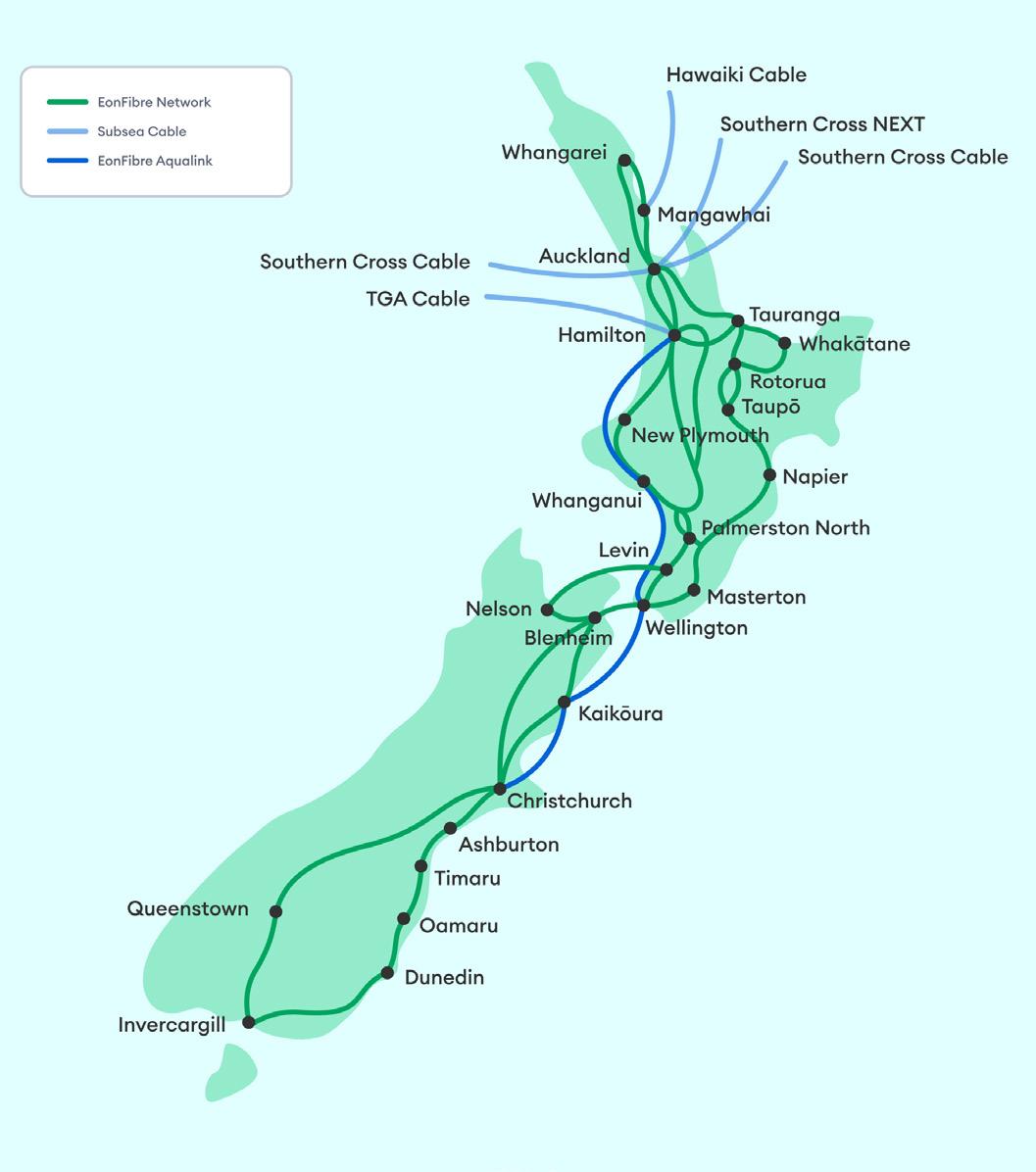

Driven by a bold ambition to become New Zealand’s leading bandwidth infrastructure provider, we’re focused on delivering premium fibre services for our customers.
Our DC Direct service offers high-performance resilient fibre connectivity between major data centres, cloud on-ramp sites, international cable landing sites and key local exchanges – making it easier than ever to power cloud computing, AI, and hyperscale workloads. We are currently positioned in 15 major data centres and growing nationally.
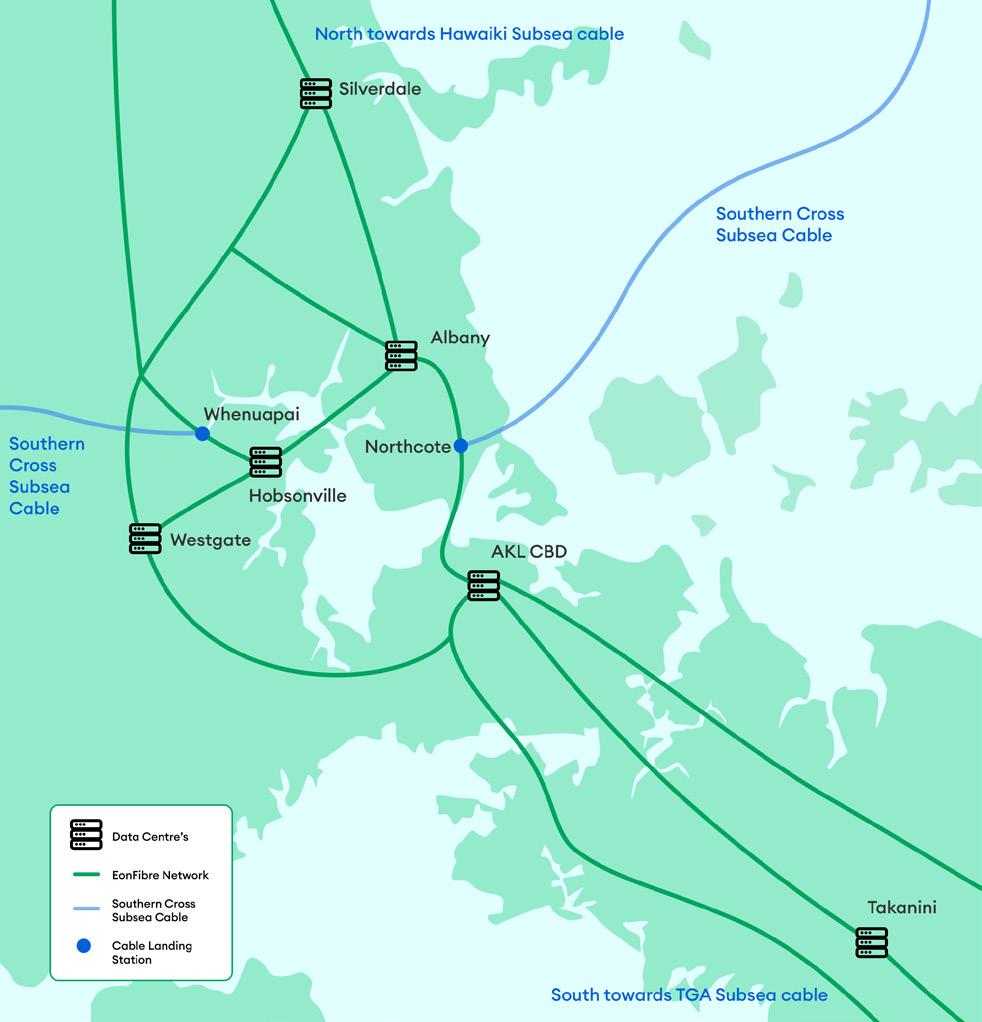
While our network map highlights key data centre locations in Auckland, our reach extends further across the North and South Islands with multiple links crossing the Cook Strait, including the 100% owned Aqualink cable.
Internationally, our global connectivity is underpinned by strategic subsea assets, including ownership in the Tasman Global
Access (TGA) cable, as well as indefeasible rights of use (IRUs) on both the Hawaiki and Southern Cross cable systems. This ensures resilient, highcapacity connectivity between New Zealand, Australia, the US, and beyond.
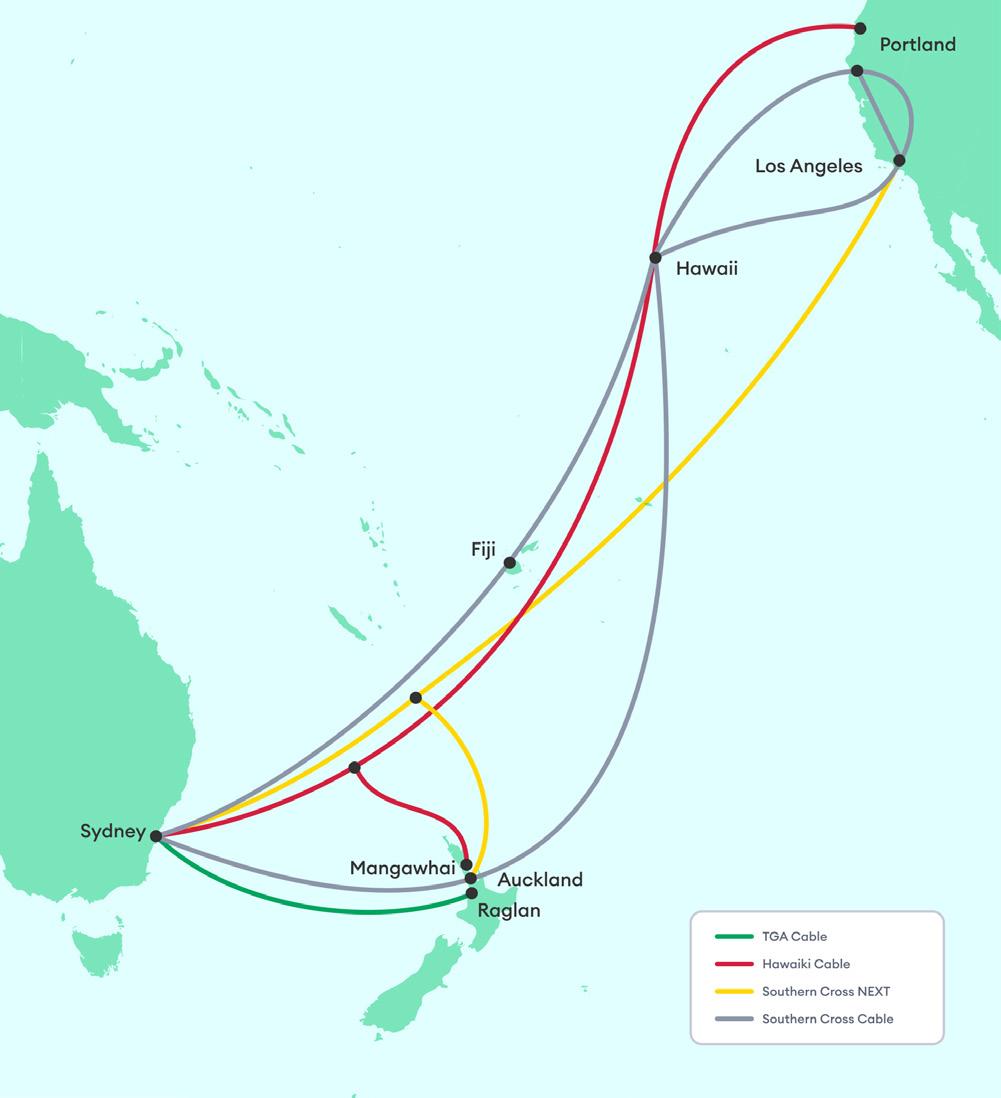
SUBSEA CABLE MAP SHOWING
AU/NZ/US CONNECTIVITY
NZ is the hub of the South Pacific — a green, neutral, high-capacity landing zone between APAC and the Americas. EonFibre has strong, reliable capacity across all subsea cable systems.
• Five international points of presence (PoPs) across the US and Australia
• Access to major telecommunications hubs and internet exchanges
With EonFibre, customers gain access to a high-capacity, low-latency network built for mission-critical workloads, from realtime cloud services and AI applications to inter-data centre replication. Whether you’re migrating infrastructure, scaling operations, or enabling hybrid cloud strategies, our network is engineered to keep your business connected and competitive.

Green power. Regulatory stability. Strategic location.
New Zealand is a globally competitive hub for digital infrastructure, offering:
• Over 80 percent renewable energy grid.
• Robust data protection and cybersecurity frameworks.
• A stable political and regulatory environment.
• Emerging data centre hubs in Auckland, Wellington, and the South Island.
What sets EonFibre apart in New Zealand’s telecommunications landscape is a deliberate and focused approach to network design. While many providers build for mass-market access with point-to-multipoint, shared-capacity models, EonFibre takes a different path — engineering a pure, high-capacity transport network built for performance.
“High bandwidth connectivity is now essential to everyday lives, connecting people, businesses, and Aotearoa to the world – particularly in the AI age, data consumption continues to skyrocket. Eonfibre is focused on being NZ’s leading high capacity, infrastructure provider for the technology and wholesale business sector.”
- Richard Mooney, CEO, Eonfibre

This transport-first architecture allows EonFibre to do what it does best: deliver wholesale optical bandwidth services without the complexity or compromises of a consumer retail access network. Our focus is building, managing, and leasing capacity on a national and international fibre optic network that enables others to scale.
By decoupling physical connectivity from service layers, we offer carriers, cloud providers, and enterprises the freedom to build exactly what they need – fast, and contention-free. It’s fibre the way it should be; built for transport, optimised for scale.


Product Description
FlexWave
Business Ethernet Premium
High-capacity optical transport service using Dense Wavelength Division Multiplexing (DWDM). Offers diverse, redundant routes across NZ and Subsea
Dedicated layer 2 pointto-point MPLS connectivity between key sites across and within major cities,
Ideal For Key Benefits
Mission-critical workloads requiring performance, resilience, and national reach.
Direct Fibre
Dark fibre solution offering complete control with dedicated optical links between fibre termination points.
Enterprises needing consistent, highperformance site-to-site connectivity.
• Low latency
• High availability
• Multiple diverse paths
• Optimised for application performance
Hyperscalers, MNOs, enterprises and service providers needing infrastructure-level access.
• Dedicated bandwidth
• Consistent performance
• Metro and intercity reach
• Delivered over EonFibre’s own network
• Full control
• High capacity
• Ideal for backhaul, last-mile, and private networking
• Scalable for future demand
At EonFibre, we offer a suite of highperformance fibre services that support the growing demands of today’s digital businesses – on land and subsea, our network products are engineered to deliver speed, reliability, and flexibility.
All services run on our protected core network, stretching from Whangarei to Invercargill and are built with Class of Service (CoS) support.
Whether you’re connecting data centres, scaling cloud workloads, or expanding across regions, EonFibre provides the bandwidth infrastructure to help you thrive in an always-on digital world.

Talk to us today and unlock your network’s next phase of growth.
www.eonfibre.nz | enquiry@eonfibre.nz
Vaughan Matthews: Head of Sales, vaughan.matthews@eonfibre.nz
Lachlan Peterson: Partner Manager, lachlan.peterson@eonfibre.nz

At that time, there wasn’t the necessary infrastructure or security in place to ensure that governmental data centres were fit for purpose, which was becoming more vital as they became a key tool for productivity.
“There was an opportunity to do something in that space around improving what a good standard looked like, with particular focus on the security aspects of physical and digital domains, the resilience efficiency of the facilities, and their ability to handle changing compute environments,” Kirker sets out.
With this in mind, CDC was formed by Boorer in 2007 with a trifecta of sustainability, security, and sovereignty at the core of its mission.
In subsequent years, the company successfully expanded to additional locations across Canberra, Sydney, and Melbourne in Australia, as well as Auckland, New Zealand (NZ), creating a data centre ecosystem centred around the government’s core agencies and shared services before branching out to public cloud providers and private sector entities of national significance.
The beginning of Kirker’s journey at
CDC coincided with the company’s expansion from purely government operations into hyperscale public cloud services.
As part of this growth, CDC made the decision to diffuse its operations to NZ, particularly as the business is partly owned by Infratil, an NZ-owned investment company, alongside Future Fund, Australia’s sovereign wealth fund, and the Commonwealth Superannuation Corporation (CSC) –a public pension service.
“Due to our ANZ ownership model, the company was keen to do something for the NZ data centre industry, and so the ingredients for establishing our first footprint outside of Australia started to really come together,” he explains.
NZ’s data centre landscape at the time was comparatively limited due to a lack of major industry investment.
“Big banks and government organisations were using on-premise and basic colocation-type facilities, so purpose-built, hyperscale-grade data centres weren’t really a thing in NZ. Some organisations, for example, had converted big warehouses into productive colocation facilities, but their resilience and security were quite poor,” Kirker recalls.
The global data centre market, meanwhile, was experiencing a major
push towards establishing sovereign cloud capabilities in smaller countries, establishing additional data centre ecosystems alongside those found in Australia, Europe, and the US.
Elsewhere, there was also considerable pressure on the NZ banking industry to operate independently if needed from many of their Australian owners, particularly as the sector strove to have domestic onshore IT systems that were purposefully developed for the country’s nationals like they were in Australia.
Within this environment, CDC was eager to capitalise on the opportunities the country had to offer, providing valuable solutions and advancing the nation’s limited data centre infrastructure.
Establishing the best location in NZ to launch CDC’s first two data centre facilities and effectively set up and house the necessary infrastructure was no mean feat, particularly given the vast range of requirements hyperscale data centres need to meet.
The start-up operation involved identifying suitable blocks of land and finding out who the owner was, before often even writing out a sale

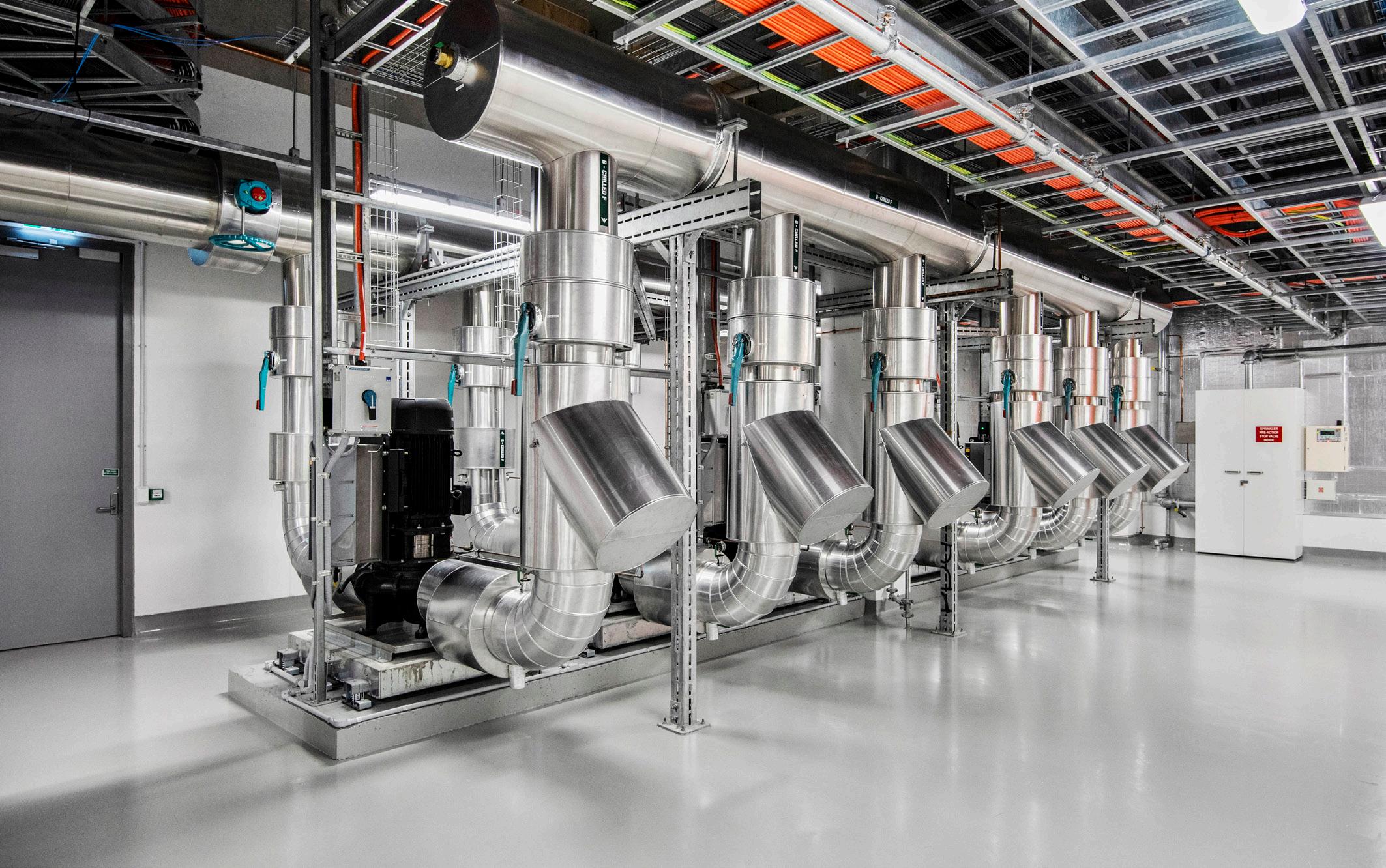
Vertiv plays a pivotal role in CDC’s ability to deliver reliable, scalable, and future-ready data centre environments.
As a trusted provider of mechanical infrastructure, Vertiv supports CDC with critical systems such as chillers, computer room air conditioning (CRAC) units, and coolant distribution units (CDUs) – essential components in the company’s liquid cooling and highdensity deployments.
The relationship is built on a foundation of technical collaboration, proactive maintenance, and shared performance goals, ensuring CDC’s facilities operate with maximum efficiency and uptime. With Vertiv’s support, CDC continues to lead the way in delivering infrastructure that meets the evolving needs of hyperscale, enterprise, and government clients.
“WE ULTIMATELY WANTED TO MAKE SURE NZ HAD THE DIGITAL INFRASTRUCTURE READY TO SUPPORT THE DATA REQUIREMENTS OF
THE
FUTURE. THIS MEANT
HAVING FACILITIES THAT WERE FLEXIBLE ENOUGH TO HANDLE THE DENSITY OF THE TECHNOLOGY AND THE SECURITY LEVELS THE FUTURE MIGHT NEED, AS WELL AS WITHSTAND THE CLIMATE CHALLENGES THE FUTURE MIGHT BRING”
– ANDREW KIRKER, MANAGING DIRECTOR – NEW ZEALAND AND HYPERSCALE ANZ, CDC
and purchase agreement and making a proactive offer to buy the site.
After Auckland was pinpointed as an area with the best type of land for the job – with the lowest risk and greatest proximity to customers and subsea networks – the company had to overcome difficulties in obtaining the right land holdings with the correct data centre attributes.
“There are numerous things that go into determining the right type of data centre land parcels. Namely, they must be suitable from a risk point of view, located somewhere that has the ability to receive the right levels
of power, isn’t prone to any natural hazards, and has the right zoning of the land,” Kirker outlines.
It took CDC approximately 20 attempts at securing land from not-always-willing sellers in different areas before the company found the optimum locations with willing sellers.
“CDC identified two perfect data centre blocks that were close enough for the performance of the facilities to be as low latency as possible, but were also far apart enough to help alleviate any potential risks.
Vertiv offers critical infrastructure technologies and rapidly-deployable customised solutions to most specific business requirements and needs.
DOWNLOAD OUR WHITE PAPER
AI’s rapid growth is reshaping IT insfrastucture, driving higher rack densities and increasing the need for reliable power and innovative cooling solutions
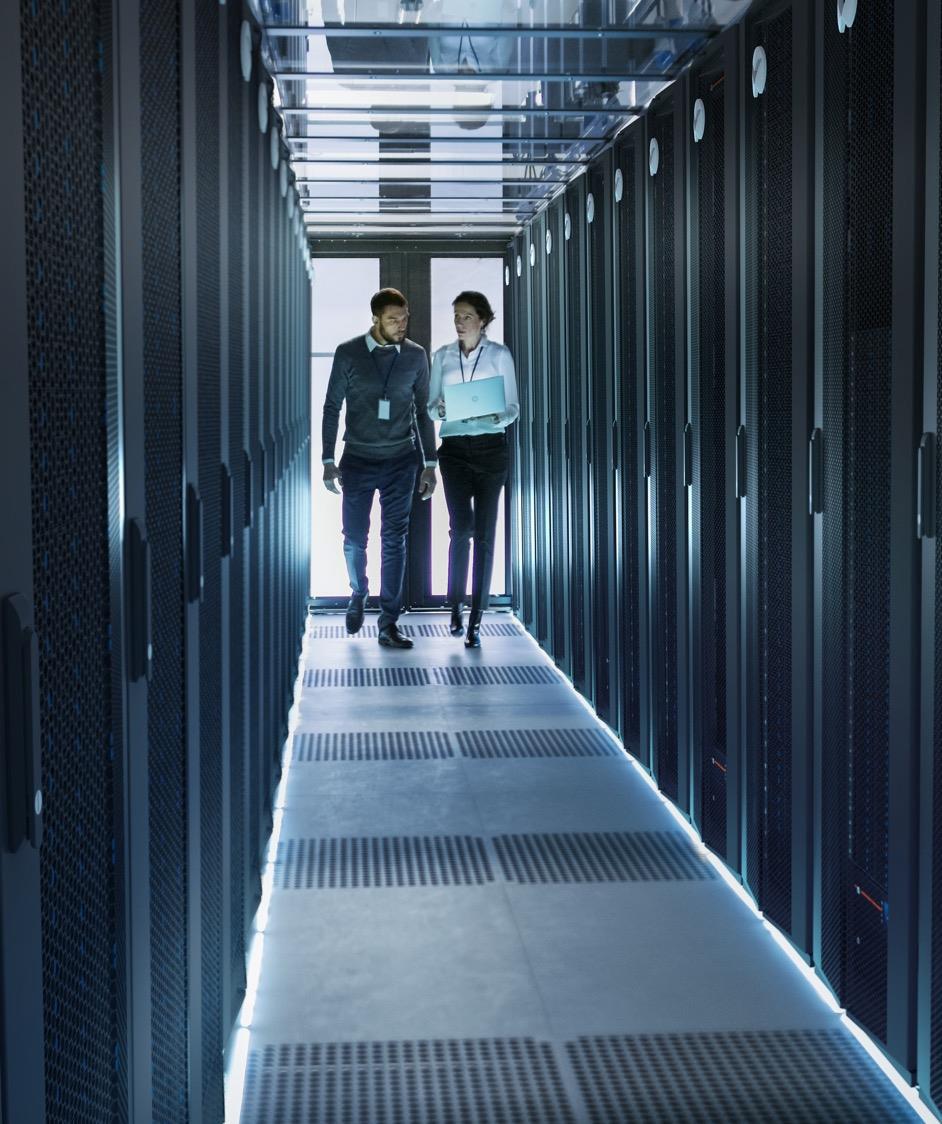



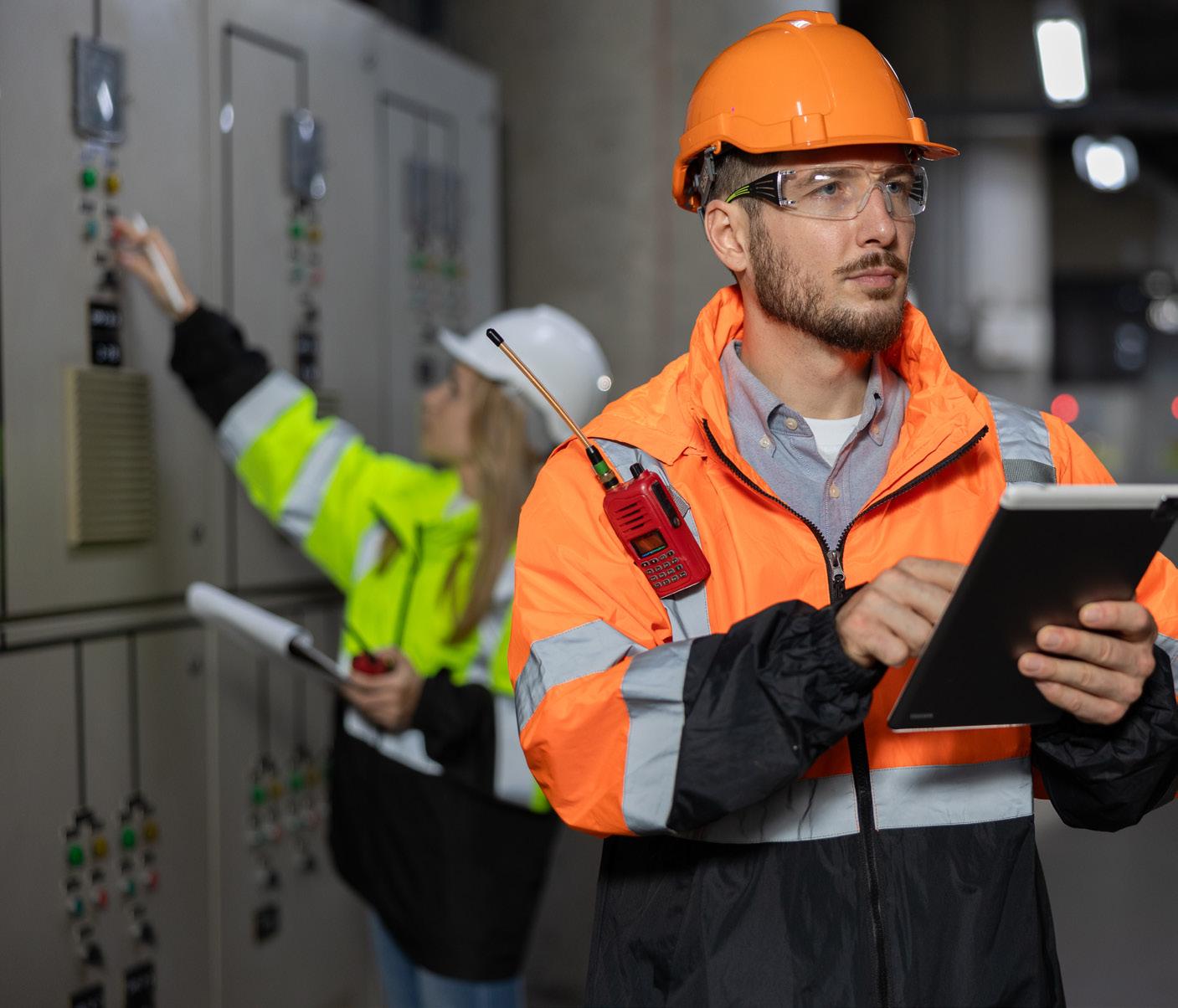
Can you please tell us what makes Vertiv a global leader in critical data infrastructure?
Vertiv is a global leader in critical digital infrastructure because we combine deep industry expertise with decades of engineering innovation. We understand what is required to keep essential systems operating at all times. Whether it’s a data centre, hospital, financial institution or telco network, our focus is on supporting critical services to stay online 24/7. What sets us apart is that we don’t just offer individual products – we deliver integrated solutions covering power, cooling, monitoring, and services. These systems are designed to work seamlessly together. And with our global capability combined with strong local teams across APAC, we’re able to support customers wherever they operate, with insight into their specific market needs.
What, for you, differentiates Vertiv from the competition?
At Vertiv, we are proud of our technical depth, the way we engage with customers, and the strength of our entire portfolio. We don’t take a one-size-fits-all approach – we take the time to understand each project, design a tailored solution, and stay engaged to support it throughout its lifecycle. We’re also uniquely positioned to manage the increasing complexity of today’s IT environments. As technologies like AI, edge computing and hybrid cloud continue to grow, they place more demand on power and cooling infrastructure. This is where Vertiv’s
modular, all-in-one solutions come into play.
Our prefabricated and factory-tested systems make it easier to deploy infrastructure quickly and efficiently, while also offering the flexibility to scale as needed –without major disruption.
We also see real value in offering a full ecosystem –not just the products, but the services and tools that support long-term operational continuity, such as predictive maintenance and remote monitoring. That level of integration gives our customers peace of mind and a clear path to growth.
How is Vertiv fuelling the revolution of the digital world through industry-leading innovative technologies and a global services network?
Innovation is at the core of everything we do at Vertiv. We are not just responding to the demands of AI, edge computing, and hyperscale growth, we are helping to shape the infrastructure that enables it.
We are leading the charge with next-generation thermal management, including liquid cooling, refrigerant-based pumped systems, and cooling distribution units specifically designed for high-density and AI workloads. These solutions are modular, scalable, and built for energy efficiency, helping data centres manage extreme heat loads without compromising sustainability goals.
Beyond cooling, we are pushing boundaries in power infrastructure, including high-efficiency UPS systems, dynamic grid support, and DCIM and power management software that enables real-time
visibility, control, and automation. Our innovations in prefabricated modular solutions allow for faster deployment, lower risk, and reduced site complexity, which is especially critical in edge and hyperscale environments.
We are also heavily investing in digital transformation and AI-driven monitoring. Our Vertiv Environet Connect and Avocent platforms deliver real-time insights that help operators predict failures, optimise energy use, and improve uptime, even on remote or distributed sites.
And above all, what sets Vertiv apart is how we bring innovation to market through our global services network, which combines international scale with deep local expertise. From engineering and design to installation, commissioning, and lifecycle services, our teams help customers navigate complexity and scale confidently with consistent support at every stage.
Whether it is AI readiness, grid independence, or rapid edge deployment, Vertiv delivers end-to-end infrastructure innovation that supports the digital world now and into the future.
Can you please tell us about your business relationship with CDC and the benefits you provide?
Vertiv has been a long-standing technology partner to CDC, supporting their rapid growth and high standards in mission-critical infrastructure across Australia. Our

partnership is built on shared values around reliability, scalability, and sustainability.
We collaborate closely with CDC across critical infrastructure areas such as power, cooling, and modular deployment, providing solutions that align with their high-performance and operational standards.
Our engineering teams work together from the early design phase, ensuring each site meets CDC’s specific goals around efficiency, reliability, and sustainability.
This deep technical engagement allows us to tailor infrastructure to CDC’s evolving needs, while ensuring long-term performance and compliance.
The scale and complexity of CDC’s national footprint requires close coordination to meet aggressive project timelines. Vertiv supports this with flexible, modular infrastructure and streamlined deployment processes, helping CDC achieve speed to market without


compromising quality, cost-effectiveness, or reliability. This partnership enables CDC to confidently scale while maintaining the resilience and sustainability expected of Australia’s leading data centre provider.
Looking ahead, what are your key priorities for the coming year? Are you aiming to hit any specific targets, reach any goals, expand, or diversify at all?
Our main priorities are to support the continued growth of our customers, the data centre industry, particularly as demand accelerates around cloud, AI, and high-performance computing (HPC). We’re focused on helping customers scale sustainably, with flexible, future-ready infrastructure that balances performance, efficiency, and resilience.
A key part of this is strengthening strategic relationships with customers like CDC. These longterm partnerships allow us to co-innovate, plan ahead, and deliver a combination of customised and prefabricated solutions that support their growth and evolving needs.
We are also expanding our presence in critical sectors such as government, manufacturing, retail, and telecom, where secure, uninterrupted operations are essential. Supporting regional development is another priority, and we’re investing in our modular infrastructure capabilities to help customers bring reliable infrastructure to more remote and distributed locations.

In parallel, we’re focused on operational excellence – driving consistency, quality, and speed in how we deliver and support our solutions across the region. This includes enhancing our supply chain, refining project execution, and ensuring high service standards at every touchpoint.
Is there anything that hasn’t been touched upon that you would like to be mentioned?
I’d just emphasise the importance of our people. We talk a lot about technology – and rightly so – but behind every successful solution is a team that’s committed, capable and focused on delivering real value. From engineering to support and service, our people are at the heart of everything we do.
Our national service team plays a vital role in that ongoing commitment. Their deep technical expertise, local presence and strong customer relationships mean we’re able to provide consistent, responsive support not just at the start of a project, but throughout the entire lifecycle of a solution. Whether it’s preventative maintenance, rapid response, or ongoing optimisation, our service teams are there to ensure our customers get the most out of their investment over time. That culture of commitment and collaboration is something we’re proud of, and I think it’s a big part of what makes Vertiv a trusted partner for so many organisations.
Solving the Power and Cooling Complexities of the AI Revolution.
In an era driven by Cloud, AI, and high-performance computing, Vertiv enables critical digital infrastructure, keeping data flowing and operations resilient where it matters most.
At Vertiv, we design, build, and service the critical infrastructure powering and cooling some of the world’s most advanced data centres. As demand surges across hyperscale, edge, and telco networks, Vertiv helps customers navigate the increasing complexity of power and cooling, especially as highdensity workloads redefine how and where data is processed.
From data centres and 5G networks to industrial and commercial sites, Vertiv offers the industry’s most comprehensive portfolio, including uninterruptible power, thermal management including liquid cooling, environmental and IT monitoring, rack enclosures, and prefabricated modular solutions. Our expertise in scalable, energy-efficient infrastructure ensures faster deployment and enhanced resilience.
Across ANZ, our local engineering teams, extensive in-country service network, and strong partner ecosystem enable tailored, future-ready solutions. Whether deploying edge-ready micro data centres or scaling colocation capacity, we combine speed, precision, and reliability.
Globally trusted and locally focused, Vertiv is committed to helping customers thrive in a digital-first world. As sustainability and uptime become nonnegotiable, we build infrastructure that is not only high-performing but also responsible by design.
The future of Cloud, AI, and high-performance computing demands more. Vertiv is ready.

“We ended up purchasing the two blocks of land about 21 kilometres apart, before securing power and other necessary elements.”
The challenge of constructing a data centre in NZ was unprecedented at the time, therefore, there was a huge amount of education required around their purpose and the processes needed to create such a services-intensive building.
In addition to this, CDC recognised an opportunity to support improvements in construction safety and worked closely with an industry that was open to change. Together, they embraced initiatives like the introduction of five mandatory personal protective equipment (PPE) items, helping to build a stronger safety culture and lift overall standards.
SECURITY – Protecting customers’ critical assets through the highest levels of security across all CDC facilities.
SOVEREIGNTY – Safeguarding Australians’ and New Zealanders’’ long-term investments through sovereign control of their assets.
GUARANTEED AVAILABILITY – On hand around the clock to support the critical nature of customers’ businesses and their outcomes.
AGILITY – Configuring data centres by providing flexible, modular, and scalable solutions to futureproof businesses.
INTERCONNECTIVITY – Ensuring the continuity of customers’ businesses through the geoconnectivity of CDC campuses and high-speed networks.
SUSTAINABILITY – Net zero carbon-certified in NZ whilst moving towards achieving net zero carbon in Australia by 2030.
However, CDC encountered further obstacles upon the emergence of the COVID-19 pandemic, particularly as lockdown measures were implemented part way through the construction process.
“This meant there were significant difficulties in establishing what you could and couldn’t do during this time.”
All this combined to create a highly challenging operational environment. Yet, despite such adversities, CDC went on to eventually open its first data centre in 2022, with an aim of pioneering forward-thinking services in an industry that had reached a tipping point.
Having overcome the practical difficulties of establishing its data centres in Auckland, CDC set about understanding the nuances of the NZ data centre landscape.
Firstly, the company strove to solve the nation’s challenges around data centre resilience, addressing the industry’s security and quality aspects that had limited progression in the past.
At Schneider Electric, sustainability is at the heart of everything we do. That’s why our recent acquisition of Motivair marks a significant milestone - enabling us to deliver a comprehensive solution from Grid to Chip to Chiller. This end-to-end approach offers substantial benefits to our customers across the data centre ecosystem. Liquid cooling, traditionally seen as a solution for high-performance, high-density computing, is now proving its value far beyond niche applications. Its advantages are increasingly relevant for both large-scale data centres and edge deployments, helping to address some of the most pressing challenges faced by designers and operators today.
From reducing energy and water consumption across diverse geographies to overcoming space constraints and operating in harsh environments, liquid cooling is poised to become a mainstream technology in the IT sector. As sustainability and efficiency continue to drive innovation, we expect its adoption to accelerate significantly in the coming years.
Air cooling complements liquid cooling and is needed to reject heat from the air-cooled components in the IT space. This includes but not limited to computer room air conditioning and air handler, fan wall, traditional perimeter, InRow, and rear door heat exchanger.

Direct-to-chip is the preferred method today, where liquid coolant is pumped through a cold plate attached directly to the chip. Cold plates can also be attached to other hot components such as memory.
Immersion is another method where components are fully or partially immersed in liquid coolant.
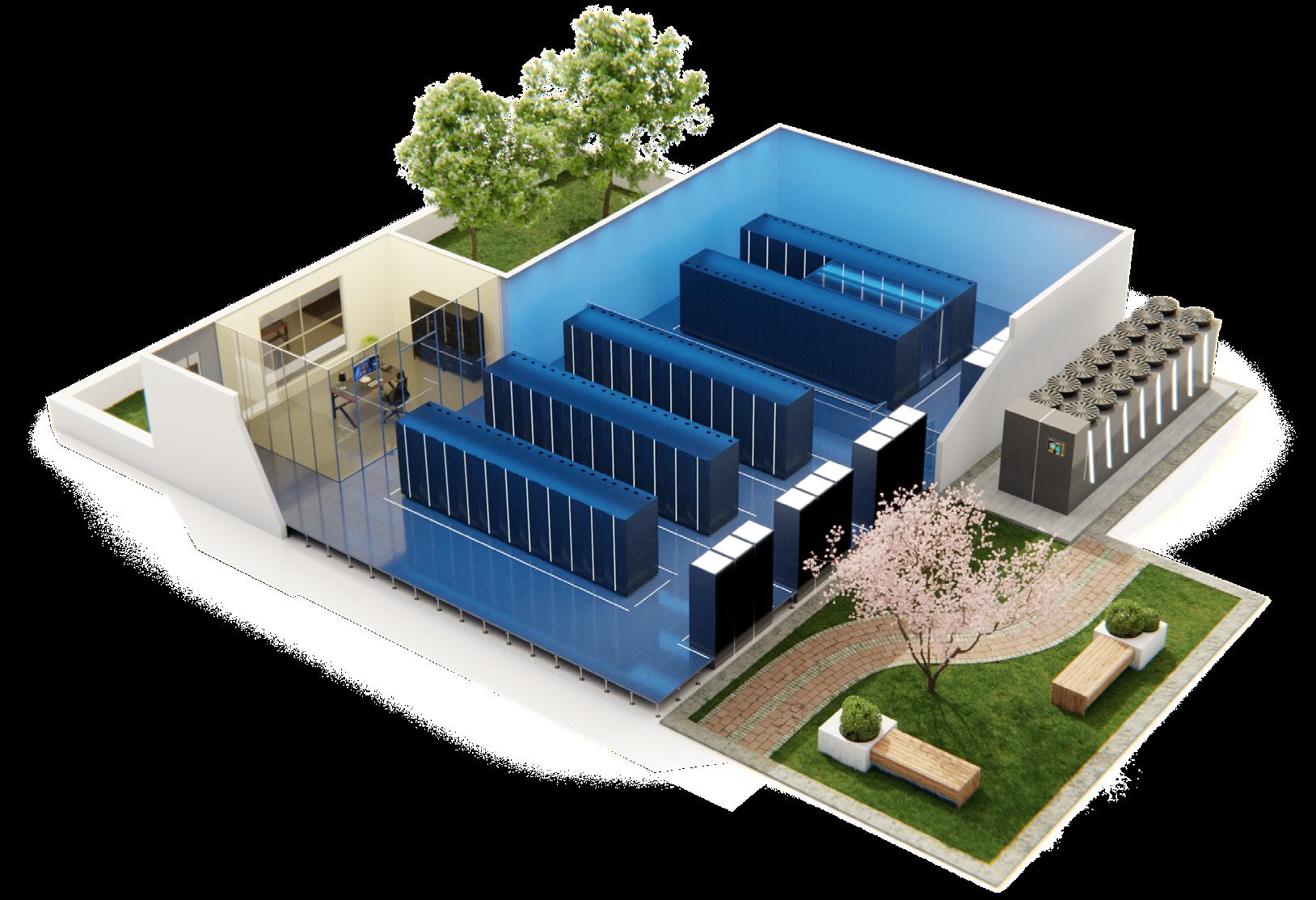

Heat rejection units, including chillers, dry coolers and cooling towers, are used to reject heat in Technical Cooling System loop to the outdoors.
Chip-to-Chiller
3 main elements in a liquid cooling ecosystem
Heat Capture Within the Server
Heat Exchange Inside the Data Center
Method of Rejecting Heat to the Outdoors
Coolant Distribution Unit (CDU)
CDU isolates the Technical Cooling System loop from the rest of the cooling system and controls temperature, flow, pressure, fluid treatment, and heat exchange.
CDUs vary in type of heat exchange, capacity, and form factor (rack- vs. floor-mounted).
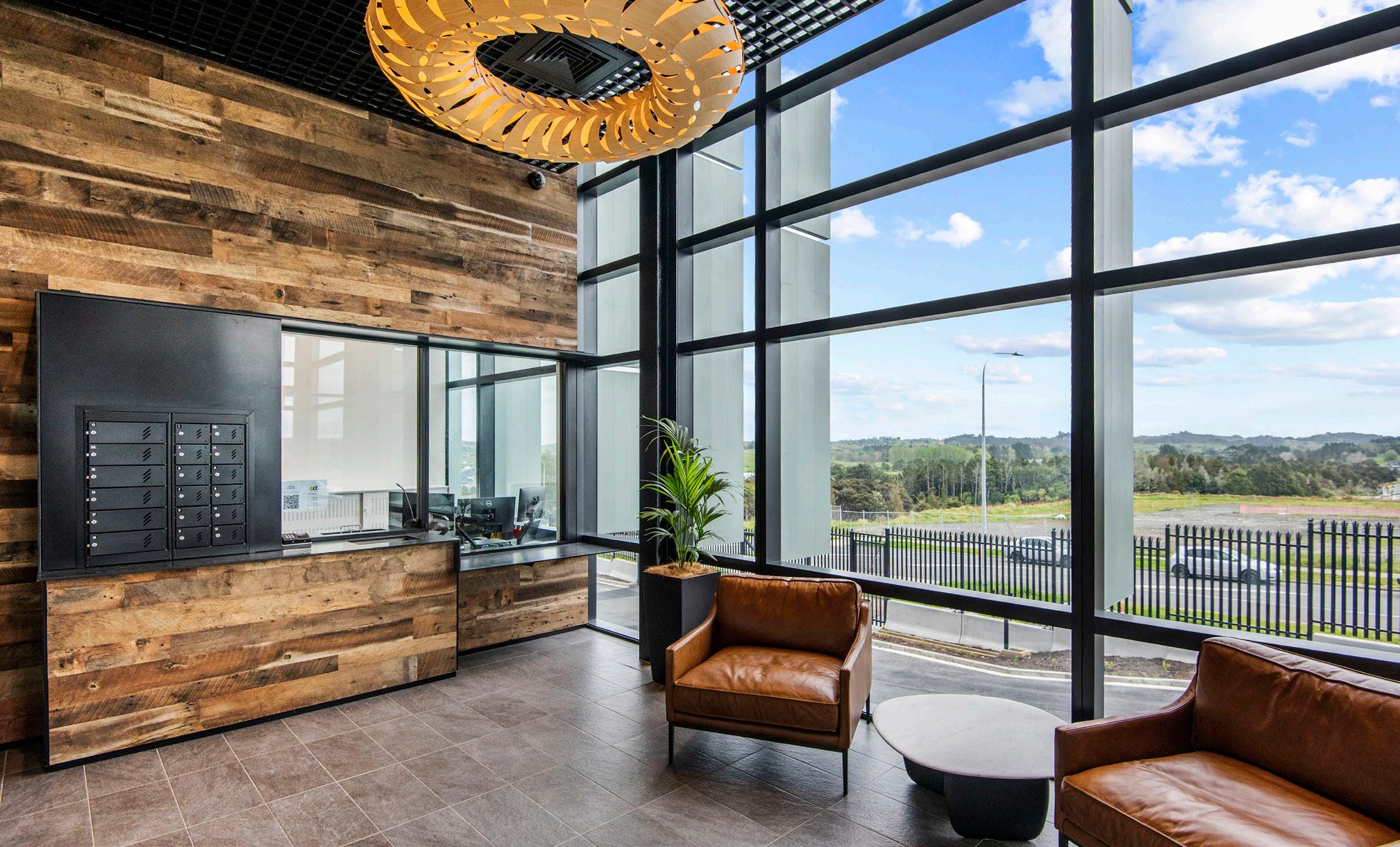
“We ultimately wanted to make sure NZ had the digital infrastructure ready to support the data requirements of the future. This meant having facilities that were flexible enough to handle the density of the technology and the security levels the future might need, as well as withstand the climate challenges the future might bring,” Kirker expands.
The local team leveraged the formula of success used in Australia to build on and localise the data centre infrastructure, crafting a handful of objectives that would allow the company to meet the needs of NZ’s digital economy.
Early due diligence undertaken by the team to understand the critical aspects required to succeed in the NZ
WOULD YOU SAY THAT IT REMAINS AN EXCITING SPACE TO WORK?
Andrew
Kirker, Managing Director – New Zealand and Hyperscale ANZ:
“Our first data centres opened their doors in NZ three years ago and it remains an invigorating, growing industry. We are set to double our capacity over the next year, which is super exciting for the team and I.
“In my 30 years in the data centre industry, I’ve seen a lot of change, including cycles of insourcing and outsourcing and technology change, amongst other things. However, the change with cloud and AI right now is nothing like I’ve seen before.
“I have to say, the industry right now is at a fever pitch in terms of change.”
market proved pivotal. This, combined with CDC’s forward-thinking approach and depth of experience, meant it had the ability to embrace the challenges and establish itself as a leader in the emerging market.
As part of its founding mission and position as an NZ hyperscale data centre pioneer, CDC’s facilities have achieved the highest levels of sustainability credentials in NZ.
“In terms of environmental responsibility, NZ runs a national grid that uses approximately 83 percent renewable energy, providing a really good starting point for us as the nation’s energy sources were highly renewable from the get-go,” Kirker points out.
As part of its sustainability targets, the company was also the first data centre business in NZ to achieve net zero carbon, which it obtained from the outset.
CDC additionally worked with Crown Research Institute (CRI), Toitū Envirocare, to establish a clear set of sustainability practices and


That first engagement at CDC’s inaugural data centre in 2022 marked the beginning of a relationship that would transform our position in the data centre security market.
CDC invested in Allied Security when we were focused on establishing ourselves as leaders in data centre security. Their confidence in our capabilities became the foundation for our global positioning in the data security market.
Data centres present unique security challenges that differ significantly from traditional commercial environments. They require stronger protection systems because they house critical infrastructure and sensitive data that many businesses rely on for their operations.
Effective data centre security demands expertise in both technical infrastructure and human workflow patterns. Our partnership with CDC allowed us to master this balance, delivering security solutions that safeguard valuable assets without disrupting daily operations. We learned to anticipate challenges before they arose and adapt our approaches as technology evolved.
CDC’s high standards pushed us to polish our performance and data centre security approach, establishing the benchmark for


data centre security across New Zealand. This positioned Allied Security as the country’s premier data centre security specialist, with each project building our expertise and strengthening our market position.
Our relationship with CDC extends beyond traditional vendor-client dynamics. Our teams collaborate across multiple touchpoints, sharing insights and maintaining strong professional relationships that enhance project outcomes. This partnership approach has become central to how we work with all our clients.
The rigorous requirements and continuous feedback from CDC’s team helped us refine our methodologies and develop innovative solutions that set new industry standards.
The strong foundation built with CDC enabled Allied Security’s strategic expansion into Australia and Canada. Our proven methodology in New Zealand, supported by CDC’s endorsement, provided the credibility needed to enter these new markets successfully.
Today, Allied Security has grown to become New Zealand’s leading security provider with an international presence reflecting the global demand for our specialised data centre security expertise. We’ve maintained
the same standards of excellence that characterised our New Zealand operations while adapting to local market requirements.
Today, CDC leads New Zealand’s data centre landscape, and Allied Security stands as the country’s premier data centre security partner.
Looking back, we see that our best achievements came from how we supported each other’s growth, creating a partnership that elevated both organisations. From that first handshake to our current position as market leaders, CDC and Allied Security have demonstrated that exceptional partnerships create exceptional outcomes.
The future looks bright because we’re building it together!
certifications to build on its near-zero water use design and zero waste target.
“We’ve achieved Toitū Envirocare’s Net Carbon Zero certification, and we’ve also received its Enviromark Diamond certification for our sustainability practices.”
CDC’s move to NZ also saw it certify the first and currently only data centre in the country under NVIDIA’s certification programme and became a key NVIDIA partner, making it a driver and frontrunner in the industry.
Elsewhere, the company was also the first business to receive the Public Cloud Data Centre Certification (PCDCC) from the NZ government.
“This is an extremely rigorous certification process around all our various data centre aspects, including everything from security and ownership structure to change of
control, amongst other things.”
Due to such a forward-thinking and ambitious strategy centred around sustainable credentials and moving the industry forwards, CDC hit its five-year business plan in NZ at the 18-month mark and has since built again, opening two extensions in early 2025.
This is a testament to the quality, resilience, and sustainability the company has brought to NZ, making a significant impact on its data centre landscape.
“I think we’ve invested circa NZD$800 million to date, with a lot more planned.
“We will soon surpass NZD$1 billion dollars invested in the near future, which will be quite a landmark. Whilst those kinds of numbers may not be massive in a US or Australian context, by NZ standards, they are pretty
game-changing for our country,” Kirker prides.
Alongside navigating the ongoing difficulties in data centre set up, CDC also had the foresight to predict future industry challenges upon its inception.
This is particularly the case for the emergence of AI that is taking the industry by storm. However, the integration of technological advancements such as these requires specialist amenities to achieve optimum success, including extensive water usage and liquid cooling considerations, which pose significant challenges for many.
Therefore, data organisations not only across the country but worldwide are having to overcome these increasing complexities, which




a wide range of specialist electrical services across Auckland and operates through three key divisions: Contracts, Servicing, and Data & Communications. We are highly regarded in the construction industry for our quality workmanship and reliability in delivering projects on time and within budget.
Backed by decades of industry experience, we have expertise in delivering top-tier electrical and data & communications solutions for commercial projects and providing on-going maintenance services. We have a commitment to best practice, a proven record in data centre installations, and are positioned to support the complex electrical needs of large-scale data centre developments across Auckland and New Zealand.
Aotea Electric Auckland are proud to be part of Aotea Group, a collaborative group of companies with a national New Zealand network of trade specialists that provide electrical, security, communications, air conditioning, fire safety, plumbing and drainage, solar, and a range of associated services nationally.




The site for CDC’s first two facilities in NZ – Silverdale and Hobsonville campuses – in Auckland is home to the country’s first ever hyperscale data centres.
Both facilities are dedicated to supporting national critical infrastructure technology programmes that underpin the security and socioeconomic wellbeing of New Zealanders. The site’s main beneficial attributes include:
200+ MEGAWATT CURRENT AND ROAD MAP CAPACITY – Offers highly connected, resilient services across three sustainable data centre campuses.
LIQUID COOLING – Used at the core to support high-density liquid cooled AI without using water resources.
24/7 ON-SITE SECURITY AND OPERATIONS – Houses comprehensive personnel and security systems backed by government certifications.
2023 CARBON NEUTRALITY – Achieved a net zero carbon certification in its first year of operation.
100% AVAILABILITY GUARANTEE – Ensures mission critical services.
are serious challenges for some of Asia Pacific’s biggest players.
CDC, however, pre-empted such challenges to ensure its success in the future.
“At the beginning of CDC, companies were focused on cooling methodologies that included vast amounts of evaporative water, for instance.
“Boorer remarked that he didn’t see this being the future. Rather, he believed liquid cooling was where things would head over time. Therefore, he decided to use a closedloop cooling system at the core of CDC’s technology to ensure we didn’t go through several swimming pools’ worth of water a day,” he recollects.
This decision also meant the company could futureproof itself as data centre density increased, primarily as liquid cooling is far more efficient and capable of handling high densities, making it far more advantageous in the rising use of complex GPUs across the industry in the last 18 months.
“Around 50 percent of global data centres didn’t initially choose liquid as a cooling methodology, and they now can’t handle these new AI workloads.
“What AI is doing for the world and the opportunities it is creating are amazing, but it is also causing an extinction-level event on some of the world’s data centre stock.”
However, due to the pioneering vision and future-based focus that CDC possessed from its inception, the company has been able to overcome these evolutions, differentiating itself not only in the NZ market but also on the international stage.
“Even our first data centre built 18 years ago in Canberra could have AI racks plugged into it – that is the kind of foresight that Boorer had to set us up for the future,” Kirker highlights.
With the ambitious goal to bring hyperscale data centres to NZ, CDC endeavours to keep growing and


Providing full cycle service for HVAC systems from project inception through to construction and project management, maintenance, and continuous commissioning monitoring for energy efficiency.


+64 9 571 9917 | service@economech.co.nz | www.economech.co.nz
continue raising the bar.
As such, the company is advancing the nation’s cutting-edge technological solutions through embedding sustainability into its strategy and comprehensive development plans, adding significant value to not only the business but the overall industry.
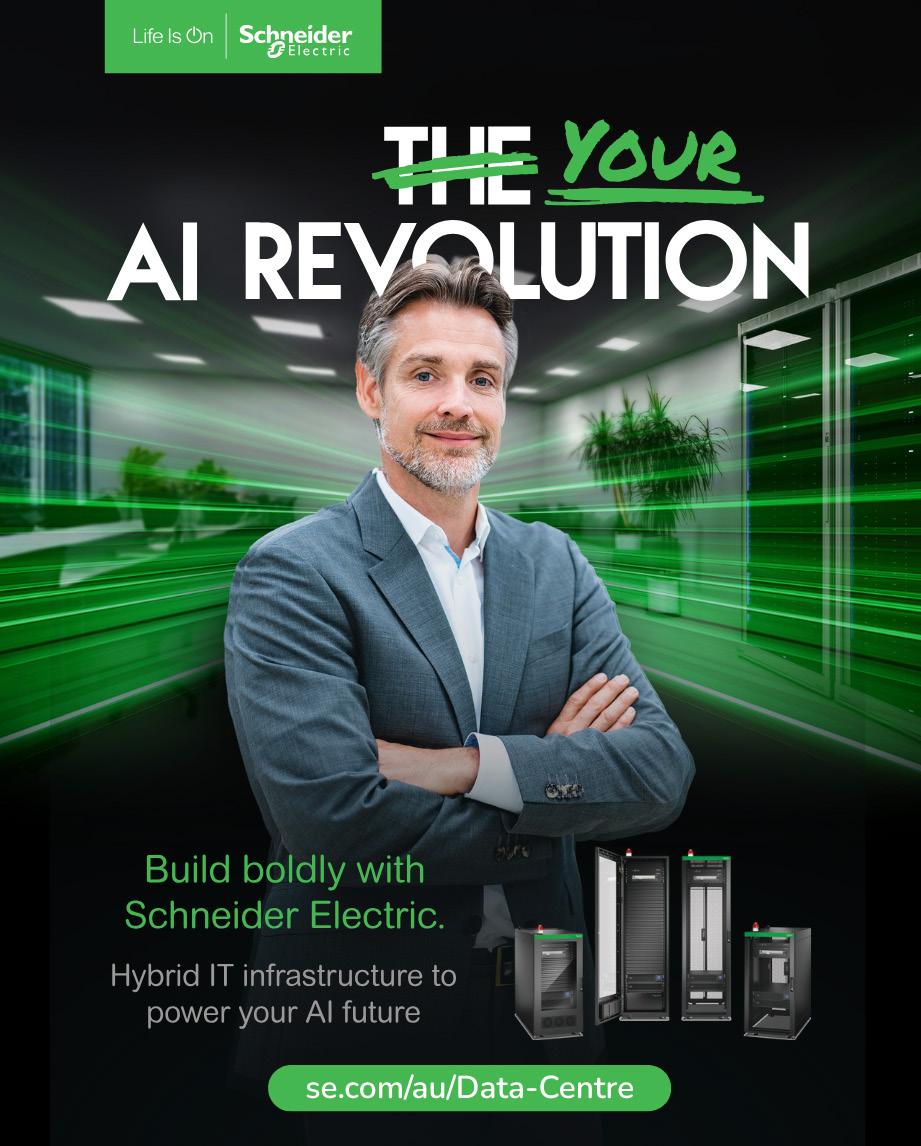
At the heart of CDC’s growth strategy is the construction of a significant mega campus, which will double the company’s size twice over. The campus will allow significant capacity to be accessed rapidly, something not common in the data centre industry.
“We’ll also continue to ‘push the
envelope’ on the technology side of things and drive efficiencies around power usage effectiveness, for instance.
“We strive to provide our customers with tangible benefits in terms of efficiency and security, alongside all the other core fundamentals that they would expect when working with CDC,” Kirker concludes.
CDC’s collaboration with Schneider Electric (Schneider) exemplifies a shared commitment to innovation, resilience, and sustainability in digital infrastructure.
As a key technology partner, Schneider provides CDC with advanced power and cooling solutions, including high-efficiency uninterruptible power supply (UPS) systems and precision-engineered battery cabinets, designed to meet the demands of hyperscale and AI-ready environments.
Schneider’s expertise in energy efficiency and life cycle management supports CDC’s mission to deliver high-performance, low-impact data centres across ANZ. Together, the two companies are shaping the future of sustainable digital infrastructure through continuous innovation and operational excellence.
By having such a hands-on approach, the company is able to uphold its primary target of maintaining 100 percent uptime for customers whilst also transforming NZ’s data centre landscape.
Australia: 1300 232 232
New Zealand: +64 9 954 6919 customerenquires@cdc.com cdc.com
